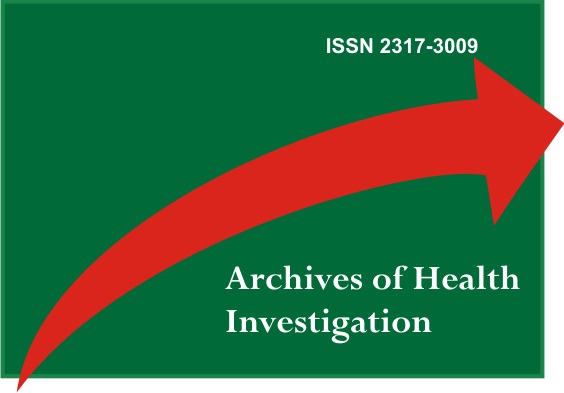Lesões orofaciais e efeitos colaterais de pacientes HIV positivos em uso da terapia antirretroviral altamente ativa
DOI:
https://doi.org/10.21270/archi.v10i2.4696Keywords:
HIV, Acquired Immunodeficiency Syndrome, Antiretroviral Therapy, Highly ActiveAbstract
Introdução: A AIDS é causada pela infecção do HIV, que progressivamente causa degradação do sistema imunológico do hospedeiro e, consequentemente, o surgimento de diferentes patologias, inclusive na região orofacial. Seu tratamento atua no impedimento da replicação viral, e é chamado de terapia antirretroviral altamente ativa (HAART). Este método terapêutico pode estar associado a alguns efeitos colaterais orofaciais e sistêmicos. Objetivo: Analisar a presença das lesões orofaciais e dos efeitos colaterais associados ao uso da HAART em pacientes HIV+. Material e métodos: Uso de um questionário semiestruturado com informações demográficas, sociais, clínicas e terapêutica, exame físico extra e intraoral, exames laboratoriais e teste de sialometria. Resultados: A amostra foi composta de 43 indivíduos, sendo 53,5% do sexo feminino com cor de pele branca e idade entre 27 e 58 anos. A maioria refere ter se infectado por meio de atividade sexual (58,1%) com diagnóstico feito nos últimos 10 anos (68,1%). A maioria teve carga viral quantificada abaixo do limite mínimo (74,4%) e contagem de linfócitos T CD4+ acima de 500 células por mm³ de sangue (56,8%). Algumas lesões orofaciais, infecções oportunistas e efeitos colaterais ao uso da HAART foram identificados, mas somente a presença de lesões orais foram diretamente relacionadas a baixa quantidade de linfócitos T CD4+ (p=0,05). Conclusão: Todo cirurgião-dentista deve estar atento a presença de lesões orofaciais de pacientes HIV+ porque isso pode indicar uma baixa contagem de linfócitos T CD4+ e, consequentemente, de baixa adesão ou falha na HAART.
Downloads
References
Geogze M, Mucci S, Marco MA, Martins LAN, Citeripo VA. Qualidade de vida e Adesão ao tratamento anti-retroviral de pacientes portadores de HIV. Rev Saúde Pública. 2010; 44:743-49.
Nungu SI, Mghamba JM, Rumisha SF, Semali IA. Uptake and determinants for HIV postpartum re-testing among mothers with prenatal negative status in Njombe region, Tanzania. BMC Infect Dis. 2019;19(1):398.
Global AIDS up date 2019, disponível em: https://www.unaids.org/es
Costa DCB, Sarmento DJS, Silveira EJD. Manifestações orais em pacientes HIV+ na era da terapia antiretroviral de alta atividade: o que mudou? – uma atualização para o clínico. Int J Dent. 2011;10(2): 97-102.
Patton LL. Oral lesions associated with human immunodeficiency virus disease. Dent Clin North Am. 2013;57(4):673-98.
Palella FJ Jr, Delaney KM, Moorman AC, Loveless MO, Fuhrer J, Satten GA, Aschman DJ, Holmberg SD. Declining morbidity and mortality among patients with advanced human immunodeficiency virus infection. HIV Outpatient Study Investigators. N Engl J Med. 1998;338(13):853-60.
Eliozondo JE, Trevino AC, Violant D. Dentistry and HIV/AIDS related stigma. Rev Saúde Pública. 2015;49:79.
Pacheco PRG, Zara ALSA, Silva E Souza LC, Turchi MD. Late Onset of Antiretroviral Therapy in Adults Living with HIV in an Urban Area in Brazil: Prevalence and Risk Factors. J Trop Med. 2019;2019:5165313.
Departamento de IST, AIDS e hepatites virais. Quais são os antirretrovirais. Disponível em: www.aids.gov.br/pagina/quais-sao-os-antirretrovirais.
Barbe AG, Ludwar L, Hamacher S, Noack MJ. Efficacy of a newly developed mouth gel for xerostomia relief-A randomized double-blind trial. Oral Dis. 2019;25(6):1519-29.
Lopez-Pintor RM, Casañas E, Gonzales-Serrano J, Serrano J, Ramirez L, de Arriba L, et al. Xerostomia, Hypossalivation, and Salivary Flow in Diabetes Patients. J Diabetes Res. 2016. doi:10.1155/2016/4372852.
Margalho R, Pereira M, Ouakinin S, Canavarro MC. Adesão à HAART, qualidade de vida e sintomat ologia psicopat ológica em doentes infectados pelo VIH/SIDA [Adherence to HAART, quality of life and psychopathological symptoms among HIV/AIDS infected patients]. Acta Med Port. 2011;24(Suppl 2):539-48.
Mwangosi IE, Tillya J. Oral lesions associated with HIV/AIDS in HIV-seropositive patients attending a counselling and treatment centre in Dar es Salaam. Int Dent J. 2012;62(4):197-202.
Patton LL, Ramirez-Amador V, Anaya-Saavedra G, Nittayananta W, Carrozzo M, Ranganathan K. Urban legends series: oral manifestations of HIV infection. Oral Dis. 2013;19(6):533-50.
Souza AJ, Gomes-Filho IS, Silva CALD, Passos-Soares JS, Cruz SSD, Trindade SC et al. Factors associated with dental caries, periodontitis and intra-oral lesions in individuals with HIV / AIDS. AIDS Care. 2018;30(5):578-85.
Ablanedo-Terrazas Y, Alvarado-de la Barrera C, Ormsby CE, Reyes-Terán G. Head and neck manifestations of the immune reconstitution syndrome in HIV-infected pat5ents: a cohort study.Otolaryngol Head Neck Surg. 2012;147(1): 52-6.
Cepeda LAG, Salobrena AC, Ortega KL, Mora NA, Soriano YJ. Oral lesions and immune reconstitution syndrome in HIV+/AIDS patient receiving highly active antiretroviral therapy. Epidemiological evidence. Med Oral Patol Oral Cir Bucal. 2008; 13(2): 85-93.
Papagatsia Z, Jones J, Morgan P, Tappuni AR. Oral Kaposi sarcoma: a case of immune reconstitution inflammatory syndrome. Oral Surg Oral Med Oral Pathol Oral Radiol Endod. 2009;108(1):70-5.
Ramírez-Amador VA, Espinosa E, González-Ramírez I, Anaya-Saavedra G, Ormsby CE, Reyes-Terán G. Identification of oral candidosis, hairy leukoplakia and recurrent oral ulcers as distinct cases of immune reconstitution inflammatory syndrome. Int J STD AIDS. 2009;20(4):259-61.
Zhang L, Li X, Lin Z, Jacques-Tiura AJ, Xu J, Zhou Y et al. Side effects, adherence self-efficacy, and adherence to antiretroviral treatment: a mediation analysis in a Chinese sample. AIDS Care. 2016;28(7):919-26.
Silva BF, Peixoto G, da Luz SR, de Moraes S, Peres SB. Adverse effects of chronic treatment with the Main subclasses of highly active antiretroviral therapy: a systematic review. HIV Med. 2019;20(7):429-38.


